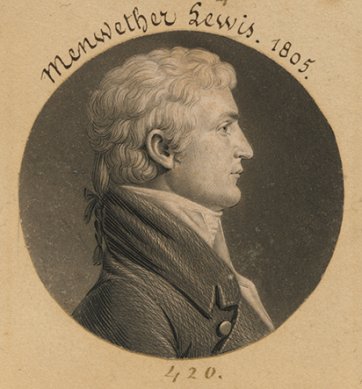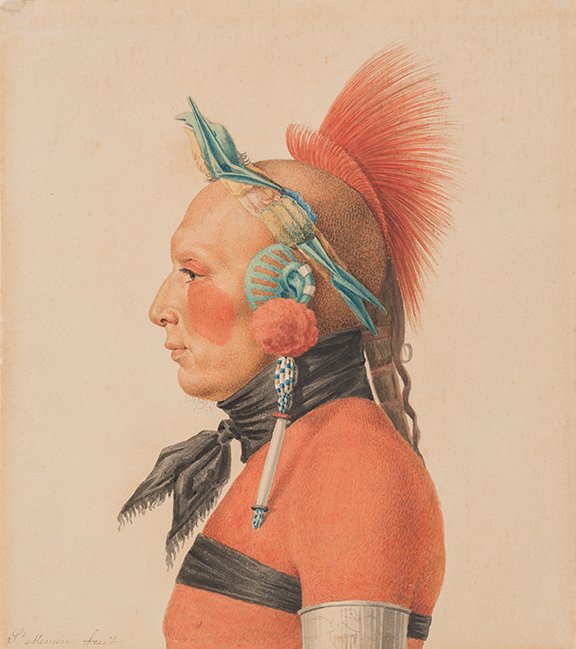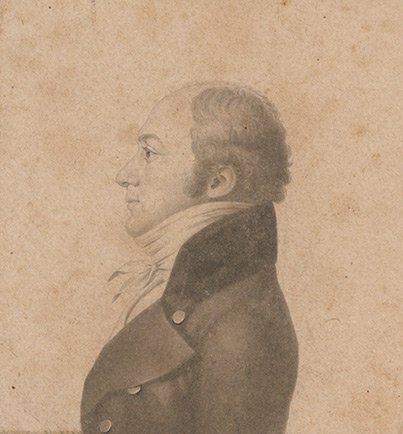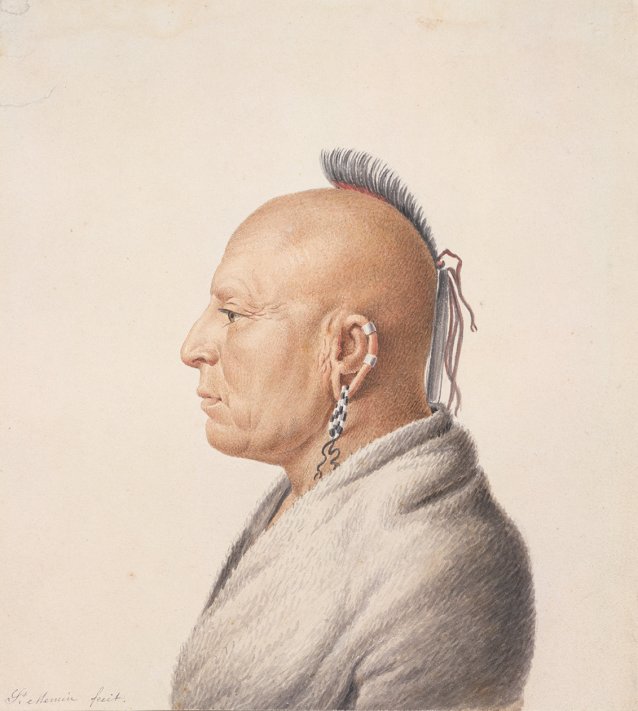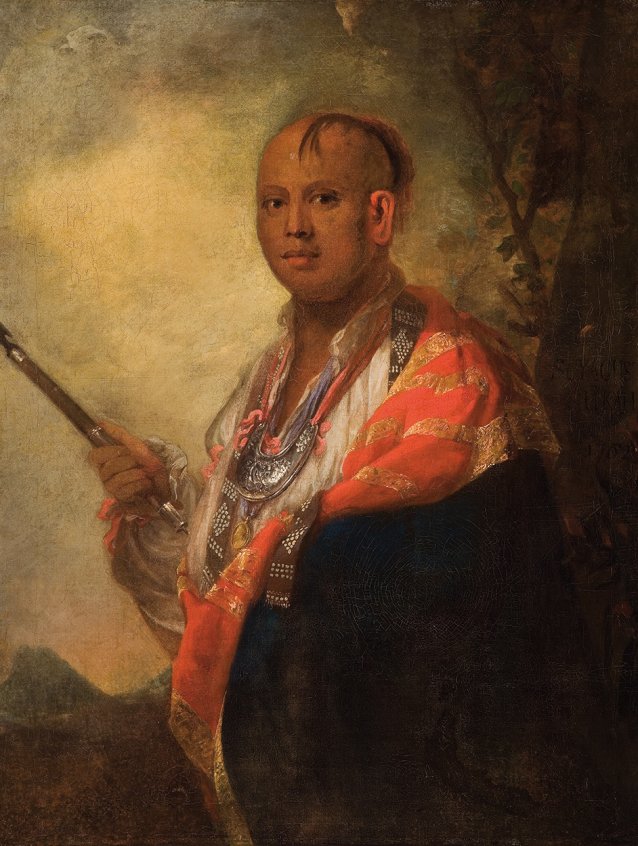On New Year’s Day 1806, the members of a visiting delegation of Osage Indians attended a public reception at the White House hosted by the then President of the United States, Thomas Jefferson. He and his eldest daughter, Martha Randolph, were present, as were his grandchildren; numerous local citizens; ‘strangers of distinction from all parts of the Union’; and the entire diplomatic corps – two British members of which departed early, affronted, because the President ‘appeared wholly taken up with his natives’. Another of the President’s guests, however, the author Margaret Bayard Smith, sided with her host in being captivated by the exotic dignitaries. ‘These Osages were noble specimens of the human race, and would have afforded fine studies for the painter or sculptor’, she recollected. ‘Tall, erect, finely proportioned and majestic in their appearance; dignified, graceful and lofty in their demeanour; they seemed to be nature’s own nobility.’
Political profiles
by Joanna Gilmour, 7 December 2016
It was actually the second time Jefferson had entertained Native American envoys at his home. The acquisition of 530,000,000 acres from Napoleon in 1803 – the Louisiana Purchase – had created seemingly untold scope for the expansion of white settlement west of the Mississippi. As such, he recognised the need for a negotiation of understandings with the region’s original custodians, who might easily mount a formidable, astute and effective resistance to accelerated dispossession (and the attendant incursions of explorers, speculators and settlers). ‘With these two powerful nations we must stand well,’ Jefferson had stated in 1804 in reference to the Osage and the Sioux nations, ‘because in their quarter we are miserably weak.’
His strategy, initiated at the outset of Meriwether Lewis and William Clark’s fabled explorations of the recently acquired Louisiana Territory (comprising all or part of fifteen present-day mid-west states), was to fund visits of ‘influential chiefs’ to Washington so as to ‘impress them strongly not only with our justice and liberality, but with our power’. Accordingly, between mid-1804 and early 1807, Jefferson welcomed three groups of Native American diplomats to the capital in order to treat with them, a tradition continued by several of his successors into the 1830s. As the art historian William H Truettner has explained, the members of these delegations observed an itinerary contrived to demonstrate both the peaceful intentions and awesome capabilities of the white authorities.
It mirrored the treatment accorded their antecedents as so-called ‘New World ambassadors’; the Cherokee warrior Ostenaco (c. 1703–1780), for instance, and the Mohawk politician and military leader Thayendanegea, or Joseph Brant (1743–1807), who both travelled to London in their roles as colonisers’ allies. Truettner notes that official Native American visitors to Washington in the early decades of the nineteenth century partook of various dinners and social gatherings, and sightseeing tours that included ‘stops at the Capitol and other imposing federal buildings, and at the Navy Yard, where frigates saluted the visitors with round after round of cannon fire, a none-too-subtle reminder of the power whites could direct against Indians’. It was usual, too, for the visitors to be presented with peace medals as a signifier of amity and allegiance.
Sittings with portrait artists also became a feature of the schedule, the resultant likenesses similarly evincing the dual motives behind these statesponsored visits from what Bayard Smith termed ‘our savage brethren from the woods and wilds of the Far West’. As Truettner elucidates in his study, Painting Indians and Building Empires in North America 1710–1840, the images of Native Americans made by European artists in this period constituted an exercise in ‘portrait diplomacy’, whereby portraits and other outward displays of peace and friendship operated in tandem with moves towards the implementation of an increasingly imperialist agenda in the decades following American independence. Consider as an example the fifteen portrait drawings made between 1804 and 1807 by Charles Balthazar Julien Févret de Saint-Mémin, which, as Truettner notes, appear to have initiated the practice of formally documenting members of Native American delegations. This group of works constitutes a small fraction of the artist’s output, yet they amount to an instructive case study in the importance of not always taking portraits at face value.
A former soldier, and of aristocratic origins, Saint-Mémin (1770–1852) had fled his native France when his family’s estates were confiscated in the early years of the Revolution. In 1793 he and his father ended up in New York, where, finding himself without an income, he decided to take up portraiture. By early 1797, having learnt engraving techniques, he was working in partnership with another French émigré, Thomas Bluget de Valdenuit; the pair advertised that they were supplying ‘Portraits on an improved plan of the celebrated Physiognotrace of Paris’, a pantograph-like apparatus that facilitated the speedy creation of highly accurate (and therefore most desirable) profile portraits. ‘From the expedition with which the work is done, and the moderation of terms,’ the advertisement continued, ‘[the artists] presume to hope that they will give satisfaction to those who … will please to encourage them with their commands.’
Saint-Mémin appears to have begun working independently within a year, and in late 1798, following Valdenuit’s return to France, relocated his business to Philadelphia, having executed a ‘great number of portraits of distinguished persons’ in New York. From 1803 to 1810 he worked itinerantly, spending several months at a time in Maryland, Washington DC, Virginia and South Carolina, answering the demands of what his American contemporary Charles Willson Peale called the ‘rage for profiles’. By the conclusion of his time in the United States, Saint-Mémin had created some 900 portraits, a body of work amounting to what art historian Ellen G Miles has described as ‘a visual “Who’s Who” of several major East Coast cities in the period between 1796 and 1810’.
This voluminous output (and the significant amount of patronage and client satisfaction it reflected) had its source in a number of factors, not the least of which was the novelty and economy of Saint-Mémin’s process. In her authoritative writings on the artist, Miles cites sources which describe the efficiency enabled by the ‘celebrated physiognotrace’, with a sitting lasting no more than six minutes, during which time the subject’s profile would be precisely traced. Saint-Mémin would then delineate the face, hair, costume and other details in chalk to complete the drawing. This initial portrait, however, was only one aspect of the service offered, the sitter also having the option of ordering multiple engravings of their likeness at a reduced size. ‘The original portrait, plate and twelve impressions shall be delivered for the moderate price of twenty-five dollars for gentlemen, and thirtyfive dollars for ladies’, Saint-Mémin advertised. For example, four dozen engravings were made of Saint-Mémin’s portrait of Jefferson, who sat for the artist at the request of his daughters in 1804. Typical of the style of practitioner commonly found in settler societies – market-oriented, sometimes self-taught, and unencumbered by ‘high art’ ideals – Saint-Mémin’s adaptability and entrepreneurial verve would also have aligned nicely with America’s emerging sense of itself as a land of unfettered opportunity. But of all the elements at play in considering Saint-Mémin’s work, what is perhaps most apposite is an understanding of the appeal of profiles and other neoclassical modes of representation in America in this period. As Miles and other art historians have pointed out, the poise and supremacy implied by profiles of Roman emperors, for example, had specific, symbolic appeal for the politicians, military heroes and prominent citizens depicted by Saint-Mémin and his contemporaries.
For neoclassicism was indeed the rage around the turn of the nineteenth century; the Enlightenment era’s reappraisal of and consequent enthusiasm for the culture of classical Greece and Rome found expression in portrait forms which, in their mimicry of ancient coins and medallions, evoked ideals of dignity, grace, nobility and power. These themes, of course, were strongly in sync with ideas about national character and identity which accompanied the advent of the new republic. By being depicted in profile and in a format designed for proliferation, Saint-Mémin’s sitters could construct and disseminate an image of themselves as leaders personifying the might of ancient emperors, and the virtues of democracy. The restraint, austerity or straight-talking simplicity of the profile – its intimate, domestic scale; its absence of allegory, symbolism, or painterly trickery, for instance – likewise befitted a new nation whose people might be inclined to associate ostentation with the decadence and supposed despotism of England, the ousted colonial power.
In addition, the physiognotrace’s satisfyingly ‘scientific’ method of making profiles correlated with prevailing understandings about ‘truth’ in portraiture — such as the belief posited by proponents of the ‘science’ of physiognomy that the essence of a sitter’s moral and spiritual character could be captured in an objective rendering of the face. Physiognomy (perhaps better known for its employment in identifying criminals and other undesirable ‘types’) increased in popularity following the publication in the 1770s of a three-volume text on the topic by Johann Caspar Lavater, a Swiss philosopher and theologian. Lavater’s treatises were illustrated with profile portraits, accompanied by his interpretations of what the various faces demonstrated about personalities, proclivities and intellects. Art historian Wendy Bellion clarifies the significance of Lavater’s theory when brought to bear on personal, sentimental portraits. For those seeking a memento of a lost or absent loved one, Bellion states, silhouettes and profiles ‘were not regarded as simple outline drawings; rather, they were understood to be imprints, material traces of a person’s physiognomy and, by extension, his or her private nature’. Accordingly, in earnestly asking her father to honour his promise to sit for Saint-Mémin, Jefferson’s daughter Maria wrote of ‘what a source of pleasure it would be to us while so much separated from you to have so excellent a likeness … It is what we have always most wanted all our lives and the certainty with which he takes his likenesses makes this one request I think not unreasonable’.

The relationship between notions about ‘truth’, character and the profile have troubling implications, however, for the comparatively few images Saint-Mémin made of Native American sitters. On the one hand, it is impossible to avoid appreciating them as an arresting, enigmatic counterpoint to almost every other portrait in the artist’s oeuvre, which is populated overwhelmingly by the precisely delineated sideways European phiz: monochrome, usually male, and embellished with cravat, epaulette, bag wig or the occasional bonnet. Against these, Saint-Mémin’s watercolours of Osage warriors stand out, perhaps most notably the example now in the collection of the Winterthur Museum in Delaware; it is part of a set believed to have been commissioned by Augustus John Foster, a British official, and one half of the pair who walked out on Jefferson’s 1806 New Year’s Day reception.
Explorer Meriwether Lewis also paid Saint-Mémin for portrait drawings of Indian sitters, to be used as illustrations for a publication which did not eventuate. It is also thought that Saint-Mémin made other portraits in the series for himself, either through his own curiosity, or in response to the ‘lively’ level of interest, official and otherwise, generated by the participants in these efforts at intercultural diplomacy. For white citizens, the Native American dignitaries were a spectacle, and their dress and appearance would have been enough to make them ‘fine studies’ for an artist of Saint-Mémin’s more pragmatic inclinations. Margaret Bayard Smith was one of various observers to express fascination with Indian dress and body decoration: ‘By the President’s desire they appeared in their own national costume,’ she wrote, ‘in their deerskin moccasins and cloth leggings ornamented with embroidery and fringes of coloured beads; their faces and bodies in full paint … and covered with blankets, worn as Spaniards wear their cloaks.’
Similarly, the inscription on the reverse of an alternative watercolour of the unnamed Winterthur Osage Warrior notes details such as his red-orange painted torso, cheeks and eyelids; his vermillion-dyed crest of hair; his headdress composed from ‘the head of a small raptor, and several waterfowl beaks, as well as hummingbird skins’; and the earring made from swan’s down and glass beads. ‘The black kerchief is worn to give an air of civilisation’, the inscription concludes. In so doing, its author has unconsciously reiterated the concept of the ‘noble savage’ and its underpinning of transactions with Native Americans in the period, both in the political realm and the artistic. Bayard Smith betrayed this, too, in referring to the Osage warriors she saw as ‘finely proportioned’, ‘dignified’, ‘majestic’ and ‘nature’s own nobility’. By this reading, Saint-Mémin’s images of the visitors might be considered a continuation of the tradition wherein portraits of Native American leaders were made in recognition of the mutually beneficial alliances hitherto formed between indigenes and newcomers.
Exemplifying this practice are the portraits made of Ostenaco and Brant during their visits to London in 1762 and 1785–86 respectively, with Ostenaco sitting for Joshua Reynolds, and Brant for George Romney, Gilbert Stuart and others. These works reflect the manner in which both had proved to be men with whom it was considered prudent and profitable to cultivate partnerships. A conventional understanding of the paintings of Ostenaco and Brant is that they depict how these individuals were perceived as ideal embodiments of the noble savage – men who had facilitated the implementation of white agendas, and hence proven capable of 'improvement’ and adaptation to European ways. Mirroring his ability to alternate ‘savage’ and ‘civilised’ guises and habits, Brant’s portraits by Romney and Stuart combine marks of his culture – a feather headdress, a tomahawk – with those of his status as a diplomat, such as his European clothing and the silver gorget presented to him by George III. In his portrait, Ostenaco wears a gorget and a peace medal with his beaded wampum and shaven head.
Saint-Mémin’s image of the Osage chief Pawhuska, the head of the inaugural delegation to Washington in 1804, likewise features indicators of cultural heritage alongside the sitter’s braided military uniform (a gift from Jefferson) – two gorgets; an armlet and peace medal (another of Jefferson’s trinkets); and the wig which he purportedly souvenired from an adversary in battle. One of Pawhuska’s white contemporaries said of him: ‘Perhaps no one brought up in savage life has ever been known to unite, with the same ease, politeness and nobleness of manners’.
On the other hand, it could be argued that Pawhuska’s portrait and the others occupying this small body of Saint-Mémin’s work represent a contrasting belief about ‘savagery’; that is, one that no longer perceived inherent nobility, daptability and capacity for reciprocity in indigenous leaders, and instead began assessing them as an obstruction to colonial progress. This, as noted by scholars who have examined the iconography of portraits made of Native Americans in the late eighteenth and early nineteenth centuries, had implications for the way in which they were depicted. Historian Kate Fullagar, for example, refers to an ‘increasing rigidity or one-sidedness of the evaluation of savagery’ during the late eighteenth century and its reflection in portraits of indigenous leaders.
Truettner, correspondingly, has written of a shift from the portrayal of the ‘Noble Savage’ to that of the ‘Republican Indian’, whereby strategic Native American allies were instead represented by portraits in which their cultural difference was emphasised – a supposed measure of the sitter’s ability to progress beyond the ‘natural’ state – and wherein their traditional means of dress and body decoration became signifiers of either obstruction to, or the inevitability of, colonial expansion and consolidation.
Saint-Mémin’s images of Native Americans are more than striking, beguiling portraits preserving extraordinary moments of crosscultural exchange. Overlaid with the era’s notions about the ‘exactness’ of profiles, and subject to contested and evolving interpretations of Native American-white relations and power dynamics, they become more complex artefacts occupying the uneasy intersections of contact.
Related information



Portrait 54, Spring 2016
Magazine
Explore an Indian treasure trove, photography by Robert McFarlane and Nan Goldin, Michael Taylor's expressionist paintings, the Great War portraits, and more!



Hottie's Snifter to port
Magazine article by Peter Jeffrey
Peter Jeffrey trips the hound nostalgic.



Natural born stiller
Magazine article by Penelope Grist
Penelope Grist speaks to Robert McFarlane about shooting for the stars.
